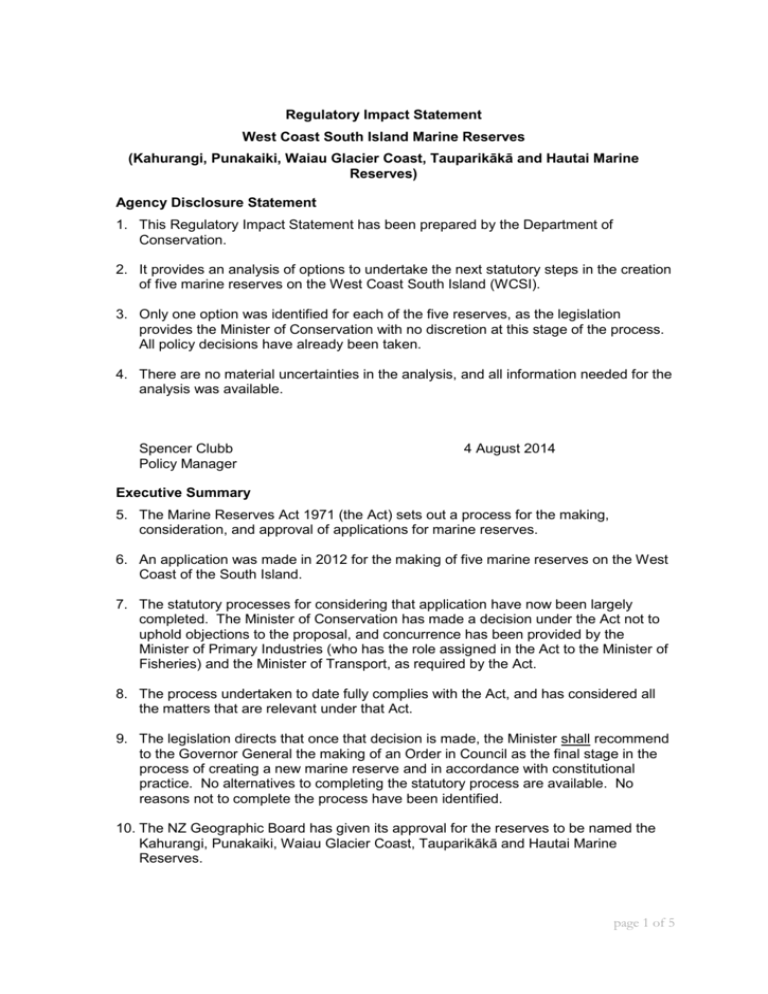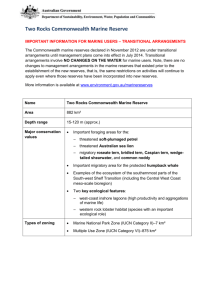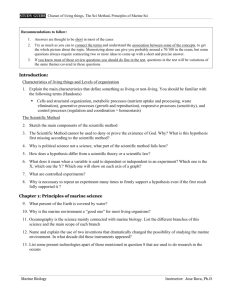West Coast South Island marine reserves
advertisement

Regulatory Impact Statement West Coast South Island Marine Reserves (Kahurangi, Punakaiki, Waiau Glacier Coast, Tauparikākā and Hautai Marine Reserves) Agency Disclosure Statement 1. This Regulatory Impact Statement has been prepared by the Department of Conservation. 2. It provides an analysis of options to undertake the next statutory steps in the creation of five marine reserves on the West Coast South Island (WCSI). 3. Only one option was identified for each of the five reserves, as the legislation provides the Minister of Conservation with no discretion at this stage of the process. All policy decisions have already been taken. 4. There are no material uncertainties in the analysis, and all information needed for the analysis was available. Spencer Clubb Policy Manager 4 August 2014 Executive Summary 5. The Marine Reserves Act 1971 (the Act) sets out a process for the making, consideration, and approval of applications for marine reserves. 6. An application was made in 2012 for the making of five marine reserves on the West Coast of the South Island. 7. The statutory processes for considering that application have now been largely completed. The Minister of Conservation has made a decision under the Act not to uphold objections to the proposal, and concurrence has been provided by the Minister of Primary Industries (who has the role assigned in the Act to the Minister of Fisheries) and the Minister of Transport, as required by the Act. 8. The process undertaken to date fully complies with the Act, and has considered all the matters that are relevant under that Act. 9. The legislation directs that once that decision is made, the Minister shall recommend to the Governor General the making of an Order in Council as the final stage in the process of creating a new marine reserve and in accordance with constitutional practice. No alternatives to completing the statutory process are available. No reasons not to complete the process have been identified. 10. The NZ Geographic Board has given its approval for the reserves to be named the Kahurangi, Punakaiki, Waiau Glacier Coast, Tauparikākā and Hautai Marine Reserves. page 1 of 5 Status quo and problem definition 11. The Act provides the statutory process for creating marine reserves. In June 2012 the Director-General of Conservation notified an application to establish marine reserves at five locations on the West Coast of the South Island. This application followed the recommendations made by the West Coast Marine Protection Forum, in accordance with the government’s Marine Protected Areas Policy and Implementation Plan (MPA Policy). 12. In considering the application, the Minister is constrained by the provisions of the Act, which set out the relevant considerations for his decision. The Act states that (s 5(9)): “If, after consideration of all objections, the Minister is of the opinion that no objection should be upheld and that to declare the area a marine reserve will be in the best interests of scientific study and will be for the benefit of the public, and it is expedient that the area should be declared a marine reserve,. . . the Minister shall, if the Ministers of Transport and Fisheries concur, recommend to the Governor-General the making of an Order in Council accordingly.” 13. The procedures set out in the Act have now been completed, with the exception of the making of the Orders in Council. On 14 April 2013 the Minister announced his decision not to uphold any objections, and to approve the reserves, and sought concurrence. The Minister of Transport gave his concurrence in November 2013, and the Minister for Primary Industries in March 2014. 14. The Minister of Conservation must now complete the final stage of the process – making the recommendation to the Governor-General of the Orders in Council. Failure to carry out that process would prevent establishment of the reserves, and be a breach of his statutory responsibilities. The proposed five reserves 15. The five marine reserves include a variety of habitat types based on depth and substrate characteristics. They share the features which, in combination, distinguish the West Coast marine environment from other New Zealand coasts: exposure to prevailing westerly winds and high wave energy action; pronounced effects of sedimentation (including glacial sediments and sand scour); and dynamic shelf and river hydrology. They are all associated with coastal landscapes that are visually spectacular and include significant areas of protected conservation lands. Together, they represent the range of variation found among the three main ‘subregions’ of the West Coast South Island Coastal Biogeographic Region. 16. Key features of each marine reserve are: 17. Kahurangi: This site includes natural examples of eight habitat types. It is a good example of the northern West Coast marine ecosystems, and adjoins natural coastlines and catchments within Kahurangi National Park. It includes rocky and sandy coast habitats reaching out to the inner continental shelf areas to depths of about 50 metres. 18. Punakaiki: This site includes natural examples of six habitat types. It is a good example of the northern West Coast marine ecosystems, and adjoins natural coastlines and catchments within Paparoa National Park. It includes rocky, gravel and cobble shore habitats reaching out to sandy seabed areas to depths of about 20 metres. page 2 of 5 19. Waiau Glacier Coast: This site includes natural examples of five habitat types. It is a good example of the central West Coast marine ecosystems, and adjoins natural coastlines and catchments within Westland Tai Poutini National Park and Te Wāhi Pounamu Southwest New Zealand World Heritage Area. It includes moraine boulder and gravel shore habitats reaching out to sandy and muddy seabed areas to depths of about 25 metres, and the gravel-bed river mouth of the Waiho River. 20. Tauparikākā: This site includes natural examples of three habitat types. It is a good example of the southern West Coast marine ecosystems, and adjoins natural coastlines and catchments within Te Wāhi Pounamu Southwest New Zealand World Heritage Area. It includes sandy shore and river mouth habitats reaching out to depths of about five metres. 21. Hautai: This site includes natural examples of five habitat types. It is a good example of the southern West Coast marine ecosystems, and adjoins natural coastlines and catchments within Te Wāhi Pounamu Southwest New Zealand World Heritage Area. It includes boulder and sand shore habitats reaching out to seabed areas to depths of about 30 metres. Objectives 22. The objective of the paper to Cabinet is to advise Cabinet of the actions which the Minister is now required to undertake in order to fulfil his statutory responsibilities under the Act and to seek authorisation for the submission to the Executive Council of the: a. Marine Reserve (Kahurangi) Order 2014; b. Marine Reserve (Punakaiki) Order 2014; c. Marine Reserve (Waiau Glacier Coast) Order 2014; d. Marine Reserve (Tauparikākā) Order 2014; and e. Marine Reserve (Hautai) Order 2014. 23. The objective of the marine reserves is to contribute to the purpose of the Act (s 3(1)) of: “preserving, as marine reserves for the scientific study of marine life, areas of New Zealand that contain underwater scenery, natural features, or marine life, of such distinctive quality, or so typical, or beautiful, or unique, that their continued preservation is in the national interest” 24. The Ministers of Conservation, Primary Industries and Transport have agreed that the applications will achieve the objective and meet the requirements of the Act. Options and impact analysis 25. The procedures for making a marine reserve that are relevant to this application are set out in sections 4 and 5 of the Marine Reserves Act 1971. 26. The process leading to this point considered a range of options and their impacts that were appropriate given the role of the various players and the requirements and constraints within which they were operating. 27. The Minister was satisfied, in making his decisions during the process to date, that the process had been robust and in accordance with the Act. The Minister did not uphold any objections. page 3 of 5 28. The Minister of Transport and Minister for Primary Industries had independent agency advice when considering concurrence, and also concluded that the application should be approved and objections not upheld. 29. Full details of the process and matters considered by the Minister of Conservation are set out in the report from the Director General of Conservation, and a separate independent report commissioned from Mr David Collins, to the Minister. Those reports are available from the Department’s Hokitika office on request. 30. Given this past process, no problems were identified with adopting the only available option at this stage of the process. 31. At this stage of the process the legislation requires that the Minister shall recommend the making of Orders in Council in accordance with the Act. Subject to the approval by the Governor-General, this will result in the creation of the marine reserves. 32. Given the statutory requirements, the Minister’s decision to recommend the making of the Orders in order to create the marine reserves cannot be changed by Cabinet. Cabinet can only decline authorisation for the Minister to give effect to his decision. That would not remove the decisions already made, but simply leave them unimplemented. Not undertaking the action required of the Minister would be a breach of the requirement imposed on him by statute. Consultation 33. The five marine reserve proposals arose from a collaborative process undertaken by the West Coast Marine Protection Forum, in accordance with the government’s MPA Policy. That Forum carried out non-statutory consultation while investigating options and preparing recommendations to the Ministers of Conservation and Fisheries, for marine protection in the West Coast region The Forum’s consultation included numerous opportunities for public input and submissions over the period 2005-2010, including public meetings, calls for submissions and individual discussions. 34. The Department subsequently carried out a formal statutory public consultation process in 2012. A total of 166 submissions were received (4 objections, 7 in support and 155 in qualified support), plus three late submissions. 35. There has been consultation on this RIS with the Ministry of Transport, Ministry for Primary Industries, Parliamentary Counsel Office, Treasury, Land Information New Zealand, Maritime New Zealand, Te Puni Kōkiri and the Ministry of Business, Innovation and Employment. 36. The Department undertook public and iwi consultation on the proposed names Kahurangi, Punakaiki, Waiau Glacier Coast, Tauparikākā and Hautai Marine Reserves. Agreement was received from the relevant Ngāi Tahu Papatipu Rūnanga (Te Rūnanga o Ngāti Waewae and Te Rūnanga o Makaawhio), but there were no public submissions. The proposed names were considered by the Secretary of the New Zealand Geographic Board and approved on 27 May 2014. Conclusions and recommendations 37. The statutory processes for considering the application for five marine reserves on the West Coast South Island have now been completed and a decision made. page 4 of 5 38. The process undertaken to date fully complies with the requirements of the Act in so far as they apply to those decisions, and has considered all the matters that are relevant under that Act for those decisions. 39. The Act directs that once the decision is made, the Minister shall recommend to the Governor General the making of Orders in Council as the final stage in the process of creating new marine reserves. 40. The only remaining steps to be completed are the making of the Orders in Council. No alternatives to completing that statutory process are available. No reasons to not complete that step have been identified. 41. The Department of Conservation recommends that Cabinet: Authorise the submission to the Executive Council of Orders in Council to establish five Marine Reserves on the West Coast South Island, namely the: a. Marine Reserve (Kahurangi) Order 2014, b. Marine Reserve (Punakaiki) Order 2014, c. Marine Reserve (Waiau Glacier Coast) Order 2014, d. Marine Reserve (Tauparikākā) Order 2014, and e. Marine Reserve (Hautai) Order 2014. Implementation plan 42. Once the Orders in Council have been signed, the reserves will be gazetted. The reserves will come into effect on 7 September 2014 (subject to a waiver of the 28 day rule being granted). 43. It is proposed that upon gazettal the marine reserve boundaries will be marked using a variety of signs on land. The seaward boundaries will be made known to the public by way of GPS and charts. 44. At the time of the official opening the change of status to the areas will be widely advertised within the community. There will then be ongoing compliance and education work to ensure that the intended effect of the gazettal will be achieved. The department will work with the local tangata whenua, the community and others, including local and government agencies to identify the best approach for integrated management over the reserves. Implementation will be closely tied to the management of national parks and public conservation lands that adjoin the five marine reserves. 45. Costs to Government from this option are expected to be minimal, with the majority of implementation, compliance and education costs to be met through existing DOC baselines. It is also expected that the reserves will generate significant benefits for the public. Monitoring, evaluation and review 46. No monitoring is required in relation to the actual gazettal process. 47. The Department of Conservation will manage the marine reserves once they have been established. page 5 of 5








